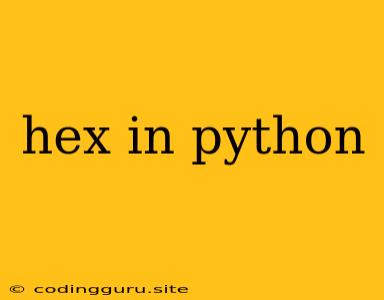Hex in Python: Unlocking the Secrets of Hexadecimal Representation
Hexadecimal, often shortened to "hex," is a numerical system that uses 16 distinct symbols. It is widely used in computer science, especially in low-level programming and network communication. In Python, working with hex numbers is straightforward and offers many advantages. Let's dive into the world of hex in Python.
Why Use Hex in Python?
- Conciseness: Representing large numbers in hexadecimal is much more concise than in decimal.
- Memory Efficiency: Hexadecimal representations often align better with computer memory organization.
- Common Usage: Many programming languages and systems utilize hexadecimal values for addresses, color codes, and data representations.
Converting Numbers to Hex in Python
Python provides the built-in hex() function for converting integers into their hexadecimal equivalents. Let's see it in action:
decimal_number = 255
hex_number = hex(decimal_number)
print(hex_number) # Output: 0xff
Understanding Hex Output
Notice that the hex() function prepends "0x" to the hexadecimal representation. This prefix is a standard convention in Python, clearly identifying the value as hexadecimal.
Converting from Hex to Decimal in Python
If you have a hexadecimal value and want to convert it back to decimal, use the int() function with the base specified:
hex_number = "0xff"
decimal_number = int(hex_number, 16)
print(decimal_number) # Output: 255
Working with Hexadecimal Strings
Sometimes you might encounter hexadecimal values as strings. Python offers ways to manipulate these strings:
hex_string = "FF"
hex_string_lower = hex_string.lower() # Output: "ff"
hex_string_upper = hex_string_upper() # Output: "FF"
Advanced Hexadecimal Operations
Beyond basic conversion, Python lets you perform various operations on hexadecimal numbers.
- Arithmetic: You can directly use hexadecimal numbers in arithmetic expressions, similar to decimal numbers.
- Bitwise Operations: Hexadecimal numbers lend themselves well to bitwise operations (AND, OR, XOR, NOT).
- String Formatting: You can use format specifiers to customize the representation of hexadecimal numbers in strings.
Hexadecimal and Color Codes
Hexadecimal is prevalent in web development for defining colors. Each color is represented by a 6-digit hexadecimal code, representing red, green, and blue components (RGB).
red_color = "#FF0000" # Full red, no green or blue
Hex in Other Python Contexts
- Network Programming: Network addresses, MAC addresses, and other network-related data are often expressed in hexadecimal format.
- Data Analysis: Hexadecimal values may be used in specific file formats or data structures encountered in data analysis tasks.
Conclusion
Hexadecimal representation is a powerful tool in Python, enabling concise and efficient manipulation of data. From basic conversions to advanced operations and color representations, Python provides the tools to seamlessly work with hex values. As you delve deeper into programming and computer science, understanding hex becomes increasingly valuable, opening up possibilities for working with low-level systems and diverse data formats.
